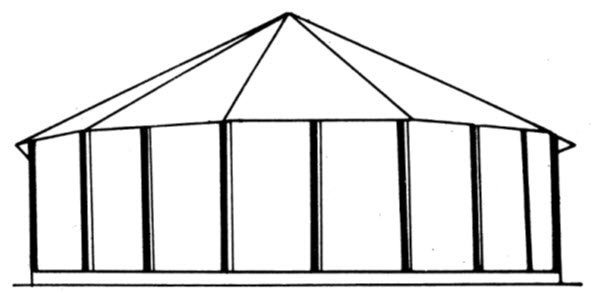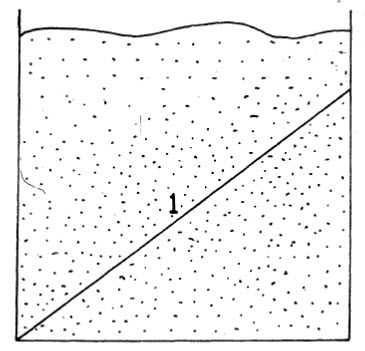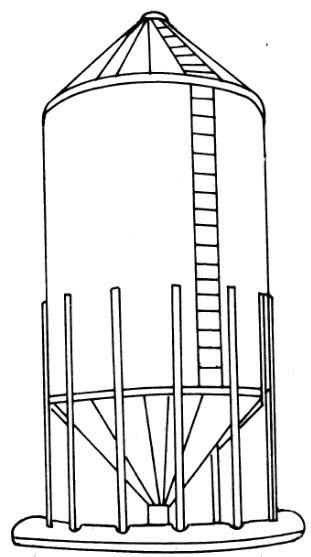Site pages
Current course
Participants
General
Module 1. Moisture content and its determination.
Module 2. EMC
Module 3. Drying Theory and Mechanism of drying
Module 4. Air pressure within the grain bed, Shred...
Module 6. Study of different types of dryers- perf...
Module 5. Different methods of drying including pu...
Module 7. Study of drying and dehydration of agric...
Module 8. Types and causes of spoilage in storage.
Module 9. Storage of perishable products, function...
Module 10. Calculation of refrigeration load.
Module 11. Conditions for modified atmospheric sto...
Module 12. Storage of grains: destructive agents, ...
Module 13. Storage of cereal grains and their prod...
Module 14. Storage condition for various fruits an...
Module 15. Economics aspect of storage
Lession–37 Types of Modern Storage structures i.e. Silo and Shed (Warehouses)
In India, for larger volume of food grains is to be stored in bulk is 'silo' and conventional godowns (shed) designed for bagged storage. Side walls of a go-down are made of brick or stone masonry and sloped roofing in asbestos or Corrugated Galvanized Iron (CGI) sheets over steel trusses. Mostly, silos are constructed either from steel or reinforced concrete. There are a cluster of adjoining silos in any modern large / capacity processing plant. The modern permanent storage system should be selected for the safe keeping of stored grains and other products. The modern storage structures should be selected on the basis of first on quality and then on cost considerations. There are following types of modern storage structures.
37.1 Silo type of storage structures
The modern facilities for storing grains in bulk are 'silo'. Silos are constructed from steel or reinforced concrete. There are a cluster of adjoining silos in any modern large capacity processing plant. These silos are generally circular with conical bottom. Bulk storage bins for storing grains can be made from reinforced concrete, plain or corrugated galvanised sheet, mild steel black sheet, aluminium sheet, fibre glass, brick, ferro cement, asbestos sheet etc. But in India mild steel bins and R.C.C. bins are quite common. The advantages of modem storage bins are, (1) less expensive and easier handling and quality control, (2) lesser space requirement, (3) savings of cost of bags, (4) provision of automation and mechanization for quicker handling and maintaining quality of stored product, (5) protection from losses due to birds and rodents.
Silos/bins are classified into two groups depending upon the relative dimensions of the container. To what extent of relative dimensions of depth and diameter or width, the structure behaves as a deep or shallow bin is decided from the concept of the plane of rupture.
The following terminology is useful for design of storage structures
Plane of rupture
The plane of rupture is that surface down which a wedge of material bounded by one wall face, the free surface, and the plane of rupture would start sliding if bounding wall were to move.
Angle of repose
When a granular product is dumped through a circular opening on a level horizontal surface, the product takes a shape of inverted cone (Fig. 37.1). The angle between the horizontal and inclination of heap is called the natural angle of repose. The angle of repose is an indicator of the product's ability to flow.

Fig. 37.1 Angle of repose
Angle of rupture
If Φ is the angle of repose of material, then the angle of rupture may be taken as ![]() with the horizontal.
with the horizontal.
The silo are classified as, (1) shallow bins and (2) deep bins.
37.1.1 Shallow bins
- A bin whose relative dimensions are such that the plane of rupture meets the grain surface before it strikes the opposite side as shown in Figure is called 'shallow bin' and is shown in Fig. 37.2.
- L and h be the breadth and depth of the storage structure, then the structure can be taken to be shallow if:

Plane of rupture
Fig. 37.2 Shallow bin
- A grain bin referred to as a shallow bin when the depth of grain is less or equal to the equivalent diameter. The equivalent diameter is taken as four times the hydraulic radius of the bin. Hd < 4R , Where Hd is depth of grain.

- A Squat silos are the example of shallow bin. A squat silo has a wall height to diameter ratio 0.5 or even less that is shown in figure. Squat silo can compete with sheds for low-cost quality storage. Squat silos are structurally efficient, thus can be built from lighter materials and costs are generally lower for a given storage volume. The . structural efficiency is achievable by the walls carrying their loads principally in tension and by the conical roof carrying its load in tension, compression and shear. Squat silos as large as having 48 metres diameter, 10.5 metres high walls and 25 metres high at roof apex are being built.(Fig. 37.3)

Fig. 37.3 Squat silo
37.1.2 Deep bins
- A bin in which plane of rupture meets the opposite side before it emerges from the grain as shown in Figure is called 'deep bin' and is shown in Fig. 37.4.
- L and h be the breadth and depth of the storage structure, then the structure can be taken to be deep if:

Plane of rupture
Fig. 37.4 Deep bin
- A grain bin referred to as a deep bin when the depth of grain is greater than the equivalent diameter. The equivalent diameter is taken as four times the hydraulic radius of the bin. Hd >= 4R , Where Hd is depth of grain.

- A vertical silos is example of deep bin. Vertical silos can be circular, hexagonal, or rectangular. They tend to be more expensive than sheds. In case of space limitation vertical silos can be used because it requires lesser space. There are two types of vertical silos used i.e. Flat bottom and Hopper bottom vertical silos. Hopper bottom silo is quite common for storing grains. Prefabricated galvanized metal silos are available in many sizes. Flat bottom vertical silos are also common. These may be fabricated by metal sheets, galvanized metal or reinforced. In hopper bottom concrete. The hopper bottom is more expensive than flat bottom bin. Hopper slope angles of 60° - 70° are necessary to achieve reliable mass flow.

Fig. 37.5 Hopper bottom vertical silo
37.2 Shed (Warehouses)
A horizontal sheds have been used to provide low- cost, large volume storage. Very large volume sheds have also been constructed by Food Corporation of India (FCI) for storing grains and other products. Sheds are usually made of steel or corrugated sheet construction with flat concrete floors.
-
Grain loads on the walls have to be supported by girts and heavy vertical butteresses designed to resist their loads in bending.
-
Roofs have to be supported on a network of purlins and rafters.
-
A typical bulk warehouse would be 15 m Wide, 60 m long and 6 m high at the edges. A building of this size would have a storage capacity of 2,840 tonnes. The same size building for bag storage has only 1440 tonnes storage capacity.
-
A 5000 tonnes conventional godown will go up about 5750 tonnes capacity by storing grains in bag and bulk combine. there is increase 17% over rated capacity. (1500 tonnes in form of bag and 4250 tonnes in bulk)
-
Belt conveyors are often used in bulk sheds for loading and unloading grains.
-
For larger sheds having 50,000-60,000 tonnes capacity a suspended drag-chain conveyor is used.

1. Sealed doors 2. Floor 3. Rat proof slab 4. Air proof roof
Fig. 37.6 Modern Godowns (Shed)